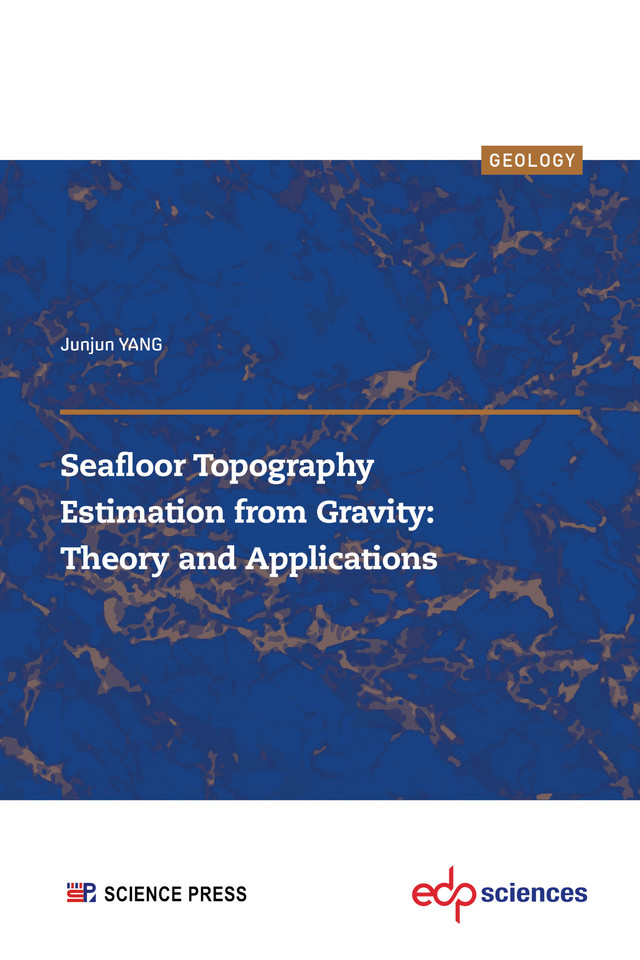Preface..................................................... V
About the Author............................................ VII
CHAPTER 1
Introduction................................................. 1
1.1 Background ............................................1
1.2 Previous Studies......................................... 1
1.2.1 Global Seafloor Topography Estimation
from Altimetry-Derived Gravity ........................ 1
1.2.2 Sub-Ice-Shelf Seafloor Topography Estimation
from Airborne Gravity ............................... 5
1.3 Objective ..............................................5
CHAPTER 2
Relationship Between Topography and Gravity....................... 7
2.1 Relationship in the Frequency Domain........................ 7
2.1.1 Parker’s Theory .................................... 7
2.1.2 Forsberg’s Method ..................................10
2.1.3 Relationships of Gravity Anomaly and Gravity Gradient
to Topography ..................................... 12
2.1.4 Admittance Theory ................................. 16
2.1.5 Advantages and Limitations of Using the Gravity Gradient ... 20
2.2 Relationship in the Spatial Domain........................... 21
2.2.1 The Gravitational Gradients Due to a Right Rectangular
Prism ............................................ 22
2.2.2 The Gravity Anomalies Due to a Right Rectangular Prism... 22
2.3 Errors Associated with Gradient Inversion Techniques............. 23
2.3.1 Truncation and Resolution Errors in the Forward
Computation ...................................... 23
2.3.2 Summary of Other Error Sources .......................27
CHAPTER 3
Estimation Methodology........................................ 29
3.1 Seafloor Topography Estimation Based on Fourier Transform ....... 29
3.2 Analysis of the Nonlinear Terms............................. 30
3.2.1 Validity of the Linear Approximation.................... 30
3.2.2 Introduction to the Coherency......................... 34
3.2.3 Coherency for Finite Power Signals..................... 36
3.2.4 Radially Symmetric Coherency .........................37
3.2.5 Coherency for Signals on the Sphere..................... 38
3.3 Seafloor Topography Estimation Using Simulated Annealing........ 43
3.3.1 Introduction to the Simulated Annealing................. 43
3.3.2 Seafloor Topography Estimation from Gravity Gradients..... 45
3.3.3 Seafloor Topography Estimation from Gravity Anomalies..... 46
3.4 Difference Between Simulated Annealing and Parker’s Method ...... 47
CHAPTER 4
Numerical Experiment......................................... 49
4.1 Study Area Description.................................... 49
4.2 Estimation Using Parker’s Formulation........................ 49
4.2.1 Data Preparation ...................................49
4.2.2 Data Filtering .....................................50
4.2.3 Determination of Topography-to-Gradient Admittance Scale . . 54
4.2.4 Results and Evaluation ..............................57
4.2.5 Results After Including Shorter Wavelengths.............. 59
4.3 Estimation Using Simulated Annealing........................ 61
4.3.1 Analysis of the Forward Computation in the SA........... 61
4.3.2 Data Preparation and SA Configuration................. 63
4.3.3 Results of the Simulated Annealing..................... 65
4.3.4 Low-Pass Filtering the Estimated Seafloor Topography...... 69
4.3.5 Evaluation ........................................ 69
4.3.6 Other Tests of the Simulated Annealing Algorithm......... 71
4.4 Comparison of the Estimation Results......................... 74
4.4.1 Comparison with the SIO Topography Model.............. 74
4.4.2 Comparison Between the Two Methods ..................75
4.5 Conclusions.............................................77
CHAPTER 5
Estimation from Airborne Gravity Gradients........................ 79
5.1 Airborne Gravity Gradients and Multibeam Bathymetry........... 80
5.2 Inversion Parameters...................................... 81
5.3 Analysis and Removal of the Non-Terrain Effects................ 81
5.4 Results, Evaluation, and Discussion.......................... 84
5.5 Conclusions.............................................86
CHAPTER 6
Seafloor Topography Offshore Northeast Greenland................... 89
6.1 Introduction............................................ 89
6.2 Data and Methods .......................................90
6.2.1 Airborne Gravity ...................................90
6.2.2 Bathymetric Data .................................. 92
6.2.3 Inversion Parameters ................................92
6.3 Results and Evaluation.................................... 93
6.3.1 Accuracy Evaluation ................................93
6.3.2 Seafloor Topography ................................94
6.4 Discussion.............................................. 97
6.4.1 Topographic Steering of Ocean Currents................. 97
6.4.2 Errors Associated with Gravity Inversion Techniques........ 99
6.5 Conclusions.............................................100
CHAPTER 7
Seafloor Topography Beneath the Amery Ice Shelf, East Antarctica ....... 103
7.1 Introduction............................................ 103
7.2 Data and Methods .......................................105
7.2.1 Airborne Gravity ...................................105
7.2.2 Laser Altimeter and Ice-Penetrating Radar Data........... 105
7.2.3 Hydrographic Data .................................106
7.2.4 Inversion Parameters ................................106
7.3 Results ................................................107
7.3.1 New Bathymetric Model .............................107
7.3.2 Water Masses Arriving at the AmIS..................... 110
7.4 Discussion.............................................. 112
7.4.1 Topographic Steering of Ocean Currents................. 112
7.5 Conclusions.............................................113
References.................................................. 115
Appendix A: The Spherical Harmonics of the Gravity Anomaly.......... 125
Appendix B: Pseudo-Code for the Adaptive Simulated Annealing......... 127


